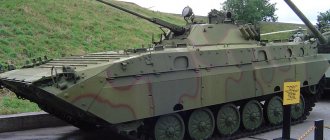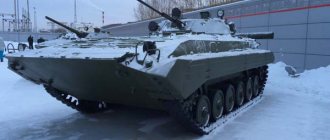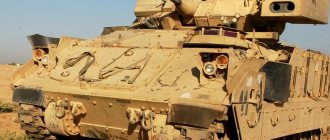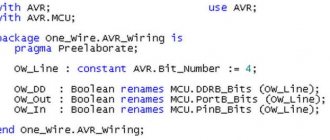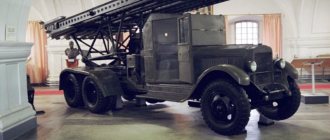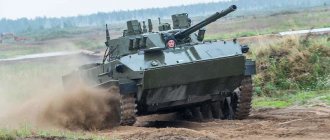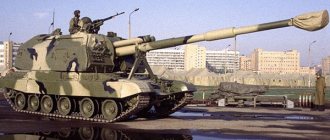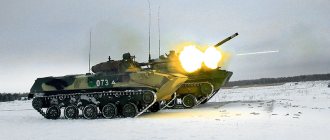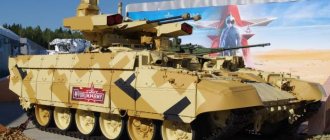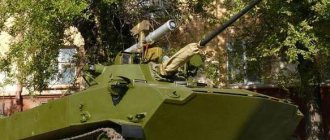| Type 85 | |
| Classification | main battle tank |
| Combat weight, t | 41 |
| Layout diagram | classical |
| Crew, people | 4 |
| Story | |
| Years of use | since 1986 |
| Basic operators | |
| Dimensions | |
| Length with gun forward, mm | 9340 |
| Case width, mm | 3372 |
| Height, mm | 2300 |
| Ground clearance, mm | 480 |
| Booking | |
| Armor type | rolled and cast steel and multilayer combined |
| Active protection | Means for setting up smoke curtains |
| Armament | |
| Caliber and brand of gun | 105 mm Type 83, Type 83-I (Royal Ordnance L7) 125 mm (unlicensed copy of 2A46) |
| Gun type | rifled |
| Barrel length, calibers | 42 |
| Gun ammunition | 42 |
| Machine guns | 1 × 7.62 mm Type 59-T machine gun, 1 × 12.7 mm Type 54 anti-aircraft machine gun |
| Other weapons | Grenade launcher smoke screen installer |
| Mobility | |
| engine's type | diesel "12150L7BW" 12-cylinder |
| Engine power, l. With. | 730 |
| Highway speed, km/h | 57 |
| Speed over rough terrain, km/h | 45 |
| Cruising range on the highway, km | 480 (600 with external tanks) |
| Specific power, l. s./t | 27,78 |
| Suspension type | individual torsion bar |
| Climbability, degrees. | 30 |
| Wall to be overcome, m | 0,8 |
| Ditch to be overcome, m | 2,7 |
| Fordability, m | 1,4 |
For the machine gun, see Type 85 (machine gun).
"Type 85"
- Chinese main battle tank, which became a turning point in Chinese tank building, completing a series of modernizations of old Soviet tanks. The main difference of the new tank is a welded turret with a developed rear niche (similar to Western tanks), mounted on the Type 88 tank chassis.
Modifications
- Type 85
- prototype. - Type 85-I
- experimental. - Type 85-II
- experimental, engine power - 800 hp, mid-80s = 105 mm Type 83-I rifled gun. - Type 85-IIA
- export modification for Pakistan = 105 mm Type 83-I rifled gun. - Type 85-IIM
- export modification for Pakistan, new turret, automatic loader, early 90s = 125 mm smoothbore gun (unlicensed copy of 2A46). - Type 85-IIAP
- licensed version for Pakistan, 1991 = 125 mm smoothbore gun (unlicensed copy of 2A46). - Type 85-III
- experimental, a more powerful 1000 hp engine is installed. and mounted dynamic protection, 1995 = 125 mm smoothbore gun (unlicensed copy of 2A46).
Notes
- International Institute for Strategic Studies.
The Military Balance 2016 / James Hackett. - London: Taylor&Francis, 2016. - P. 242. - ISBN ISBN 9781857438352. - International Institute for Strategic Studies.
The Military Balance 2016 / James Hackett. - London: Taylor&Francis, 2016. - P. 280. - ISBN ISBN 9781857438352. - International Institute for Strategic Studies.
The Military Balance 2016 / James Hackett. - London: Taylor&Francis, 2016. - P. 471. - ISBN ISBN 9781857438352.
Links
Second generation M1 Abrams AMX-56 Leclerc K2 Black Panther MBT-70 ·
MBT 3000
·
Osório
· PT-91 · TR-85M1 ·
TR-125
· Arjun · Oplot BM · M2001 · M-84D ·
M95 Degman
· Al-Khalid · Leopard 2 · C1 Ariete · Songun-915 · Challenger 2 T
-55-64
T-64BV T-64BM T-
64E T
-72B T-72BA T-72B3 T-72M4 CZ T-80 T
-80A
T-80U T- 90 ·
T-90AM
·
T-84
· T-84U ·
T-84-120
· Merkava 3 and 4 · Type 90 · Type 10 ·
Type 85 · Type 96 · Type 99Third generation T-14 · FMBT ·
MBT-80
·
MCS
·
AltayItalic experimental samples or those that did not go into mass production were identified
NATO tanks Centurion Chieftain Vickers Challenger Leopard Leopard 2 OF-40 M46 Patton M47 Patton II M48 Patton III M60 M1 Abrams AMX-30 Tanks from third countries TAM Merkava Vijayanta Type 88 K1 Pz.61 Pz.68 Strv 103 Type 61 Type 74 Upgraded options M51 Shot Magah M4/FL10 Strv 74 Oliphant Medium tanks Type 58 Type 59 Heavy tanks WZ 111 Main battle tanks Type 69 Type 79 Type 80 Type 85 · Type 88 · "Jaguar" *
Type 90-II
Type 96 Type 98 ZTZ-99 MBT 2000*
MBT-3000
*BMP Type 86 YW 307 Type 92 Type 97 ZBD-04 ZBD2000 ZBL-09 VN12 Airborne combat vehicles ZBD-03 Armored personnel carriers Type 55 Type 56 Type 63 WZ-511 WZ-523 ZSD-89 (YW 534) Type 90 (YW-535) Type 92A ZFB-05 BRM QL550 VN3 Self-propelled howitzers Type 70-I Type 83 Type 89 SH1 SH2 PLZ-05 PLZ-07 (SH3) PLZ-45 PLL-05 PLL-09 Self-propelled mortars PLL-09 ZSU and air defense systems Type 63 ·
Type 88
· PGZ-07 · PGZ-95 · LD-2000 · Yitian · FK-3 · Sky Dragon 50 · CS/SA-5Anti-tank self-propelled guns Type 89 PTL-02 BMRA (MLRS) Type 63 Type 81 Type 82 Type 83 Type 89 WS-1 WS-2 WS-3 A-100 PHL-03 AR1A AR3 WM-80 WM-120 ATGM combat vehicles WZ-550 BREM Type 653 * - produced only for export; italics experimental samples and those that did not go into mass production were identified
Type 85 (NVH-1) / YW-307/309, Infantry fighting vehicle
YW-307 INFANTRY VEHICLE
The YW-307 infantry fighting vehicle was developed by the Chinese company NORINCO on the basis of the YW-534 (“Type 89”) tracked amphibious armored personnel carrier, which in turn is an improved modification of the YW-531H (“Type 85”) armored personnel carrier. The welded steel body of the BMP provides protection from bullets and shell fragments. Its front part is occupied by the logistics department (on the right) and the control compartment (on the left). Behind the driver is the commander's seat. The troop compartment houses 7 fully equipped infantrymen. The placement of the crew and troops is similar to that adopted on the Russian BMP-1. The sides have 4 embrasures for firing from the shooters' personal weapons. Marines can use the aft door and two rectangular hatches in the roof of the hull.
A characteristic feature of the vehicle is the use of a single-seat rotating turret with a remotely located 25-mm automatic cannon and a coaxial 7.62-mm machine gun. The gun is a copy of the American M242 Bushmaster. Weapon pointing angles in the vertical plane are from -12 to +52 degrees. Ammunition for the gun is 400, for the machine gun - 1000 rounds. The tower has 2 blocks of 4 smoke grenade launchers. The gunner has his own hatch in the turret roof, around which periscopes are mounted. The fighting compartment is completely identical to those installed on other Chinese infantry fighting vehicles - the tracked WZ-501A and the wheeled WZ-551.
The vehicle’s power plant uses a 4-stroke air-cooled diesel engine “Deutz” BF8L 423F with a power of 235 kW (320 hp). A simple mechanical transmission provides 4 forward gears and 1 reverse gear, the turning mechanism includes side clutches and brakes. The chassis is five-bearing with three support rollers, the support rollers are gable, rubber-coated, and the suspension is torsion bar. The caterpillar has a rubber-metal joint. The YW-307 infantry fighting vehicle can overcome water obstacles by swimming by rewinding its tracks at a speed of up to 6 km/h. On the upper frontal part of the hull there is a hydraulically driven wave guard. The standard equipment of the vehicle is a collective system of protection against weapons of mass destruction, PPO, radio station “889” and intercom system “803”.
Several experimental YW-307 vehicles were produced and officially put into service, but they did not go into series.
MAIN FEATURES OF YW-307
Combat weight, kg – 15400 Crew (landing force), people. – 3 (7) Main dimensions, mm: – Length along the body (with the gun forward) – 6150 (-) – Width – 3134 – Height – 2556…2932 – Ground clearance – 420 Obstacles to be overcome: – rise, deg. – 50 – ditch, m – 2.1 – wall, m – 0.7 – ford, m – floats Armament (ammunition, shots): – 25-mm M242 “Bushmaster” cannon – 1 (400) – 7.62- mm coaxial machine gun – 1 (1000) Vertical guidance angles, degrees: -12…+52 Loading mechanism – belt feed Number of embrasures (of which for machine guns) – 5 (-) Means of setting up a smoke screen – 2x4 grenade launchers Engine type and brand: diesel “Deutz” BF8L 423F Maximum power, hp (kW) – 320 (235) Number of cylinders – 8 (V-engine) Specific power, hp/t – 20.78 Transmission: mechanical, 2 side clutches ; 4 forward gears, 1 reverse Maximum speed (afloat), km/h: 65 (6) Cruising range, km – 500 Armor, mm – bulletproof
INFANTRY VEHICLE YW-309 (“Type 85”)
Based on the amphibious tracked armored personnel carrier “Type 85” (YW-531H), NORINCO has developed a family of combat vehicles under the same designation, which includes the YW-309 infantry fighting vehicle. The YW-309 infantry fighting vehicle is essentially a YW-531H armored personnel carrier with a fighting compartment from the WZ-501 infantry fighting vehicle (BMP-1). The vehicle body, its layout, engine, transmission, chassis - everything is completely identical to the basic armored personnel carrier. In the middle part of the hull there is a single turret with weapons. It has a circular rotation, the pointing angles of the 73-mm smoothbore gun and the coaxial 7.62-mm machine gun in the vertical plane range from -3.5 to +30.5 degrees (that is, the vertical aiming sector is shifted up by half a degree). On the gun mantlet there is a guide for the HJ-73 “Red Arrow” ATGM (a copy of the Soviet “Malyutka-P”) with an ammunition load of 4 missiles.
On the left side of the vehicle's hull there are 3 embrasures with periscopic instruments, 4 of the same embrasures on the starboard side and 1 in the aft door. The combat crew of the vehicle consists of 3 crew members and 8 fully equipped infantrymen. 4-barrel smoke grenade launchers are mounted on the sides in the front of the hull.
The BMP was created as an export model, but was not widely used.
MAIN FEATURES OF YW-309
Combat weight, kg – 14700 Crew (landing force), people. – 3 (8) Basic dimensions, mm: – Body length (with gun forward) – 6270 (-) – Width – 3060 – Height – 2475 – Ground clearance – 467 Average specific ground pressure, kg/cm2. – 0.591 Obstacles to be overcome: – rise, deg. – 35 – ditch, m – 2.2 – wall, m – 0.6 – ford, m – floats Armament (ammunition, rounds): – 73 mm 2A28 cannon – 1 (40) – 7.62 mm coaxial machine gun – 1 (2000) – PU ATGM HJ-73 “Red Arrow” – 1(4) Vertical guidance angles, degrees: -3.5…+30.5 Weapon stabilizer – no Loading mechanism – electromechanical Aiming devices: 1PN22M1 (periscope ., day/night) Number of embrasures (of which for machine guns) – 8 (-) Means of setting up a smoke screen: 2x4 grenade launchers Type and brand of engine: diesel “Deutz” BF8L 413F Maximum power, hp (kW) – 320 (235) Number of cylinders: 8 (V-engine) Specific power, hp/t – 21.77 Transmission: mechanical, 2 side clutches; 4 forward gears, 1 reverse Maximum speed (afloat), km/h: 65 (6) Cruising range, km – 500 Armor, mm – bulletproof
INFANTRY VEHICLE NVH-1
At the end of 1984, the Chinese state-owned company NORINCO and the British company Vickers Defense signed a contract for the development of infantry fighting vehicles. The first prototype was assembled in 1986 and named NVH-1 (N-NORINCO, V-Vickers, N-1 - the Chinese armored personnel carrier N-1 (YW-531H) was adopted as the base). The vehicle uses a new two-man turret developed by Vickers (the same as on the Warrior BMP). In early 1988, it was announced that the NVH-1 belongs to the Type 85 family of armored vehicles. The infantry fighting vehicle was created specifically for export, but has not yet been sold anywhere. The length of the NVH-1 hull is slightly longer than that of the original YW-531H armored personnel carrier. The body, produced by NORINCO, is welded from steel armor plates, of relatively low height, and provides protection from bullets and shell fragments. It houses the driver (front left) and an infantry squad of 8 riflemen (rear). The MTO occupies the right front part of the hull, where the West German 320-horsepower BF8L 413F diesel engine is located. The embarkation and disembarkation of shooters is carried out through the aft single-leaf door opening to the right. The door has a standard embrasure that allows the use of personal weapons of shooters. There are 2 rectangular hatches in the hull roof above the troop compartment. On the sides of the hull there are 6 more embrasures (three per side) with glass blocks, identical in design to the Type 86 infantry fighting vehicle (BMP-1).
The commander and gunner are located in the turret. For all-round visibility, 7 periscopes are installed in the turret, and in the middle part of its roof there is a rotating periscope, which can be used by both the commander and the gunner. For shooting, they use linked “Avimo NVL-53” sights with 1- and 8-fold magnification and fields of view of 25 and 8 degrees, respectively. Both sights are equipped with laser protection, have aiming scales and are designed to be compatible with second-generation NVD modules. A laser rangefinder based on a neodymium-activated yttrium-aluminum garnet can be installed in the gunner's sight. The measured range (from 300 m to 10 km) is displayed in the field of view of the sight of the day or night channels. As an alternative, a combined day/night OIP LRS5 system is offered, which includes a laser rangefinder and a highly capable ballistic computer. The drives for pointing weapons installed in the turret are electric with manual override. The gunner and commander can fire from it. The turret is equipped with a suspended deck with fencing and a mesh door that slides to the left for access to the troop compartment.
The main armament of the NVH-1 infantry fighting vehicle is a 30-mm L21A1 Rarden automatic cannon. It is automatic based on the recoil of a long-stroke barrel and can fire single shots or bursts of six shots. Power supply: three-round cassettes, rate of fire 80...90 rounds/min. The relatively low rate of fire increases accuracy. The same purpose is served by dampers installed at the end of the barrel casing and dampening its vibrations when fired. Maximum firing range 4000 m. Vertical guidance angles from 0° to +45°. Spent cartridges are removed through a special hatch outside the turret. The gun is equipped with a conical flame arrester and a reloading handle. It does not have a stabilizer, so aimed fire can only be carried out from short stops. The ammunition, located in the turret between the commander's and gunner's positions, includes unitary cartridges of several types, including armor-piercing sub-caliber and practical. Ammunition for the Swiss 811L Oerlikon cannon can also be used. The standard equipment of the machine is a protection system against weapons of mass destruction, containing a fire protection device and an air conditioner. To set up smoke screens, 2 blocks of 4 66 mm caliber grenade launchers are used, mounted on the cheekbones of the turret. The machine is equipped with a West German V-shaped 8-cylinder air-cooled Deutz diesel engine, produced in China under license, and a simple manual transmission with 5 forward gears and 1 reverse gear. The chassis of the vehicle contains 5 gable rubberized support rollers and 3 support rollers per side, torsion bar suspension, tracks with rubber-metal parallel joints and removable asphalt shoes. The vehicle can overcome water obstacles by swimming with preparation. Installing the device for this takes 20 minutes.
A variant of the NVH-4 floating without any preparation has been developed. It has a 700 mm longer hull and an additional suspension unit on each side. Its weight is 17 tons, the maximum speed on the highway is 60 km/h. It can mount the English 30-mm Rarden automatic cannon or the Swiss 25-mm Oerlikon KVV cannon.
MAIN CHARACTERISTICS OF NVH-1
Combat weight, kg – 16000 Crew (landing force), people. – 3 (8) Basic dimensions, mm: – Length along the hull (with the gun forward) – 6125 (-) – Width – 3060 – Height – 2770 Obstacles to be overcome: – ford, m – swims with preparation Armament (ammunition, rounds): – 30-mm cannon L21A1 “Rarden” – 1 (520) – 7.62-mm coaxial machine gun L94A1 – 1 (2000) Vertical guidance angles, degrees: 0…+45 Weapon stabilizer – no Loading mechanism – chain Aiming devices: “Avimo NVL-53” (periscope, daylight); NVD Number of embrasures (of which for machine guns) – 7 (-) Means of setting up smoke screens – 2x4 grenade launchers Engine type and brand: diesel “Deutz” BF8L 413F Maximum power, hp (kW) – 320 (235) Number of cylinders – 8 (V-shape) Specific power, hp/t – 20 Transmission: mechanical; gears: 5 forward, 1 reverse Maximum speed (afloat), km/h: 65 Cruising range, km – 500
Excerpt describing Type 85
Napoleon rode on, dreaming of that Moscou that so occupied his imagination, and l'oiseau qu'on rendit aux champs qui l'on vu naitre [a bird returned to its native fields] galloped to the outposts, inventing in advance everything that was not there and what he will tell his own people. He did not want to tell what really happened to him precisely because it seemed to him unworthy of telling. He went to the Cossacks, asked where the regiment that was in Platov’s detachment was, and in the evening he found his master Nikolai Rostov, who was standing in Yankov and had just mounted horseback to take a walk with Ilyin through the surrounding villages. He gave another horse to Lavrushka and took him with him. Princess Marya was not in Moscow and out of danger, as Prince Andrei thought. After Alpatych returned from Smolensk, the old prince seemed to suddenly come to his senses from his sleep. He ordered militiamen to be collected from the villages, to arm them, and wrote a letter to the commander-in-chief, in which he informed him of his intention to remain in the Bald Mountains to the last extremity, to defend himself, leaving it at his discretion to take or not take measures to protect the Bald Mountains, in which he would be taken one of the oldest Russian generals was captured or killed, and announced to his family that he was staying in Bald Mountains. But, remaining himself in Bald Mountains, the prince ordered the sending of the princess and Desalles with the little prince to Bogucharovo and from there to Moscow. Princess Marya, frightened by her father's feverish, sleepless activity, which replaced his previous dejection, could not decide to leave him alone and for the first time in her life allowed herself to disobey him. She refused to go, and a terrible thunderstorm of the prince’s wrath fell upon her. He reminded her of all the ways in which he had been unfair to her. Trying to blame her, he told her that she had tormented him, that she had quarreled with his son, had nasty suspicions against him, that she had made it her life's task to poison his life, and kicked her out of his office, telling her that if she he won't leave, he doesn't care. He said that he did not want to know about her existence, but warned her in advance so that she should not dare to catch his eye. The fact that he, contrary to Princess Marya’s fears, did not order her to be forcibly taken away, but only did not order her to show herself, made Princess Marya happy. She knew that this proved that in the very secret of his soul he was glad that she stayed at home and did not leave. The next day after Nikolushka’s departure, the old prince dressed in full uniform in the morning and got ready to go to the commander-in-chief. The stroller had already been delivered. Princess Marya saw him, in his uniform and all the decorations, leave the house and go into the garden to inspect the armed men and servants. Princess Marya sat by the window, listening to his voice coming from the garden. Suddenly several people with frightened faces ran out of the alley. Princess Marya ran out onto the porch, onto the flower path and into the alley. A large crowd of militiamen and servants was moving towards her, and in the middle of this crowd several people were dragging a little old man in a uniform and orders by the arms. Princess Marya ran up to him and, in the play of small circles of falling light, through the shadow of the linden alley, she could not give herself an account of the change that had taken place in his face. One thing she saw was that the former stern and decisive expression on his face was replaced by an expression of timidity and submission. Seeing his daughter, he moved his weak lips and wheezed. It was impossible to understand what he wanted. They picked him up, carried him into the office and laid him on that sofa that he had been so afraid of late.
Description
It uses the same system with pistonless gas automatics. The tape feed system is also identical to the Type 77, as is the barrel change mechanism.
The main difference between the Type 85 and its predecessor is the layout of the trigger and cocking system, modeled after the Czechoslovakian ZB-53. The launch module is a separate unit, which is located at the bottom of the receiver. To cock the shutter, you need to remove the trigger lock, then press the trigger using the horizontal handles that are attached to the device. After the trigger mechanism is brought to the front position, its sear engages the bolt.
The body weight of the machine gun is 24 kg. The machine weighs 17.5 kg. Total length 2150 mm, barrel length 1000 mm.
Type 85 is equipped with an open sight and has a mount for optical, thermal imaging, night, etc. sights. Used on the machine or turrets. Equipped with tubular shoulder pads.[6]
